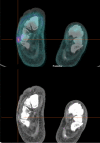State of the art of 18F-FDG PET/CT application in inflammation and infection: a guide for image acquisition and interpretation
- PMID: 34277510
- PMCID: PMC8271312
- DOI: 10.1007/s40336-021-00445-w
State of the art of 18F-FDG PET/CT application in inflammation and infection: a guide for image acquisition and interpretation
Abstract
Aim: The diagnosis, severity and extent of a sterile inflammation or a septic infection could be challenging since there is not one single test able to achieve an accurate diagnosis. The clinical use of 18F-fluorodeoxyglucose ([18F]FDG) positron emission tomography/computed tomography (PET/CT) imaging in the assessment of inflammation and infection is increasing worldwide. The purpose of this paper is to achieve an Italian consensus document on [18F]FDG PET/CT or PET/MRI in inflammatory and infectious diseases, such as osteomyelitis (OM), prosthetic joint infections (PJI), infective endocarditis (IE), prosthetic valve endocarditis (PVE), cardiac implantable electronic device infections (CIEDI), systemic and cardiac sarcoidosis (SS/CS), diabetic foot (DF), fungal infections (FI), tuberculosis (TBC), fever and inflammation of unknown origin (FUO/IUO), pediatric infections (PI), inflammatory bowel diseases (IBD), spine infections (SI), vascular graft infections (VGI), large vessel vasculitis (LVV), retroperitoneal fibrosis (RF) and COVID-19 infections.
Methods: In September 2020, the inflammatory and infectious diseases focus group (IIFG) of the Italian Association of Nuclear Medicine (AIMN) proposed to realize a procedural paper about the clinical applications of [18F]FDG PET/CT or PET/MRI in inflammatory and infectious diseases. The project was carried out thanks to the collaboration of 13 Italian nuclear medicine centers, with a consolidate experience in this field. With the endorsement of AIMN, IIFG contacted each center, and the pediatric diseases focus group (PDFC). IIFG provided for each team involved, a draft with essential information regarding the execution of [18F]FDG PET/CT or PET/MRI scan (i.e., indications, patient preparation, standard or specific acquisition modalities, interpretation criteria, reporting methods, pitfalls and artifacts), by limiting the literature research to the last 20 years. Moreover, some clinical cases were required from each center, to underline the teaching points. Time for the collection of each report was from October to December 2020.
Results: Overall, we summarized 291 scientific papers and guidelines published between 1998 and 2021. Papers were divided in several sub-topics and summarized in the following paragraphs: clinical indications, image interpretation criteria, future perspectivess and new trends (for each single disease), while patient preparation, image acquisition, possible pitfalls and reporting modalities were described afterwards. Moreover, a specific section was dedicated to pediatric and PET/MRI indications. A collection of images was described for each indication.
Conclusions: Currently, [18F]FDG PET/CT in oncology is globally accepted and standardized in main diagnostic algorithms for neoplasms. In recent years, the ever-closer collaboration among different European associations has tried to overcome the absence of a standardization also in the field of inflammation and infections. The collaboration of several nuclear medicine centers with a long experience in this field, as well as among different AIMN focus groups represents a further attempt in this direction. We hope that this document will be the basis for a "common nuclear physicians' language" throughout all the country.
Supplementary information: The online version contains supplementary material available at 10.1007/s40336-021-00445-w.
Keywords: FDG; Imaging; Infection; Inflammation; PET.
© Italian Association of Nuclear Medicine and Molecular Imaging 2021.
Conflict of interest statement
Conflict of interestThe authors declare no conflict of interest.
Figures







Similar articles
-
More advantages in detecting bone and soft tissue metastases from prostate cancer using 18F-PSMA PET/CT.Hell J Nucl Med. 2019 Jan-Apr;22(1):6-9. doi: 10.1967/s002449910952. Epub 2019 Mar 7. Hell J Nucl Med. 2019. PMID: 30843003
-
18F-FDG PET/CT in Infective Endocarditis: Indications and Approaches for Standardization.Curr Cardiol Rep. 2021 Aug 7;23(9):130. doi: 10.1007/s11886-021-01542-y. Curr Cardiol Rep. 2021. PMID: 34363148 Free PMC article. Review.
-
The value of 18F-FDG-PET/CT in identifying the cause of fever of unknown origin (FUO) and inflammation of unknown origin (IUO): data from a prospective study.Ann Rheum Dis. 2018 Jan;77(1):70-77. doi: 10.1136/annrheumdis-2017-211687. Epub 2017 Sep 19. Ann Rheum Dis. 2018. PMID: 28928271
-
Assessment of the diagnostic accuracy of 18F-FDG PET/CT in prosthetic infective endocarditis and cardiac implantable electronic device infection: comparison of different interpretation criteria.Eur J Nucl Med Mol Imaging. 2016 Dec;43(13):2401-2412. doi: 10.1007/s00259-016-3463-9. Epub 2016 Sep 5. Eur J Nucl Med Mol Imaging. 2016. PMID: 27596984 Clinical Trial.
-
Diagnostic Accuracy of 18F-FDG PET/CT in Infective Endocarditis and Implantable Cardiac Electronic Device Infection: A Cross-Sectional Study.J Nucl Med. 2016 Nov;57(11):1726-1732. doi: 10.2967/jnumed.116.173690. Epub 2016 Jun 3. J Nucl Med. 2016. PMID: 27261514 Review.
Cited by
-
Case-control study of the characteristics and risk factors of hot clot artefacts on 18F-FDG PET/CT.Cancer Imaging. 2024 Aug 27;24(1):114. doi: 10.1186/s40644-024-00760-1. Cancer Imaging. 2024. PMID: 39192363 Free PMC article.
-
Role and potential of 18F-fluorodeoxyglucose-positron emission tomography-computed tomography in large-vessel vasculitis: a comprehensive review.Front Med (Lausanne). 2024 Aug 7;11:1432865. doi: 10.3389/fmed.2024.1432865. eCollection 2024. Front Med (Lausanne). 2024. PMID: 39170047 Free PMC article. Review.
-
Evaluating ChatGPT responses to frequently asked patient questions regarding periprosthetic joint infection after total hip and knee arthroplasty.Digit Health. 2024 Aug 9;10:20552076241272620. doi: 10.1177/20552076241272620. eCollection 2024 Jan-Dec. Digit Health. 2024. PMID: 39130521 Free PMC article.
-
FDG-PET-CT as an early detection method for tuberculosis: a systematic review and meta-analysis.BMC Public Health. 2024 Jul 29;24(1):2022. doi: 10.1186/s12889-024-19495-6. BMC Public Health. 2024. PMID: 39075378 Free PMC article. Review.
-
[18F]FDG PET/CT for identifying the causes of fever of unknown origin (FUO).Am J Nucl Med Mol Imaging. 2024 Apr 25;14(2):87-96. doi: 10.62347/OQQC6007. eCollection 2024. Am J Nucl Med Mol Imaging. 2024. PMID: 38737639 Free PMC article. Review.
References
Publication types
LinkOut - more resources
Full Text Sources
Research Materials
Miscellaneous
